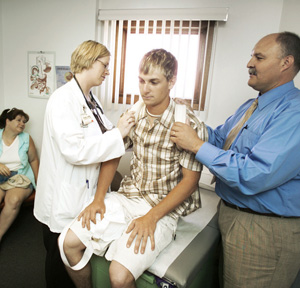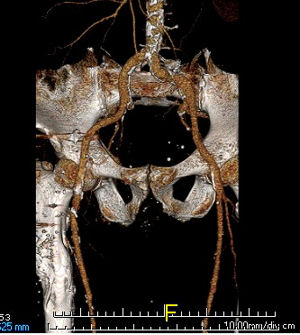Primary care works in cooperative, close-knit North Dakota
Eccentricities and efficiencies make North Dakota rise to the top quartiles of health care rankings for access, quality, use, equity and outcomes.
Cathy Houle, MD, a family physician in Hettinger, N.D., occasionally has to send her patients off to the city for specialist care—not surprising in a town of 1,307 people. But when she makes a referral, it's not to some anonymous urban doc.
“I pick up the phone and call a surgeon in Bismarck,” Dr. Houle said. “We know each other on a first-name basis. We could pick each other out on the street. In North Dakota, everybody knows each other.”

The close-knit nature of the medical community is just one of the ways that health care in North Dakota differs from that offered in the rest of the country. In a recent report, “The North Dakota Experience: Achieving High-Performance Health Care through Rural Innovation and Cooperation,” the Commonwealth Fund highlighted the eccentricities and efficiencies of this geographically large but sparsely populated state. (The report is available online. )
North Dakota is one of the most rural states in the country, yet it has come out above average on access, quality, utilization, equity and health outcomes in recent rankings, in the top quartile across the measure set, said Mary Wakefield, PhD, director of the Center for Rural Health at the University of North Dakota and a member of the Commonwealth Fund's Commission on a High Performance Health System.
In the Fund's state-by-state scorecard, North Dakota was ninth in the country at avoiding hospital use and cost, 17th in the equity and healthy lives categories, 18th in access, 20th in quality, and 13th on the overall ranking.
According to the Dartmouth Atlas of Health Care, North Dakotan medicine is also very efficient, offering highly rated care for Medicare patients despite having the lowest reimbursement rates in the country.
What's their secret?
Researchers and North Dakota medical experts attribute the state's success to a number of factors. It's hard to envision CMS bonuses targeting neighborliness, but North Dakota health care providers say that their sense of friendly, shared responsibility for the community's health is key.
“It's hard to imagine if you've never lived in a small state. You end up feeling like you know everybody in the state—kind of a band of brothers and sisters,” said James D. Brosseau, FACP, ACP Governor for North Dakota.
The sense of community means that health care providers are unusually eager to cooperate with each other. Marlene Miller is a program director of the Center for Rural Health, which facilitates network-building among small rural hospitals. The facilities share resources from quality improvement staff to health information technology and use their collective size to negotiate reduced rates from varying consultants.
Necessity is also the mother of cooperation. “In North Dakota, our health care facilities are not so rich that they can afford to pursue new initiatives without thinking first of knocking on the door of a neighbor and asking for help,” said Dr. Wakefield.
With a limited and small patient population and fixed overhead, the rural hospitals are very interested in ways to share costs and increase profitability. “We heard examples of directors of nursing or quality improvement coordinators spending half a day trying to figure out if a new regulation applies to them and then learning that it didn't and thinking, ‘Couldn't somebody have helped with that?’” said Ms. Miller.
Old-fashioned general internists
The state's outpatient care systems are typically also low on money and staff, which inspires more cooperation. “The small towns are dying, but the people living there don't want to see their towns disappear, so they're willing to work with the larger clinics to keep some presence,” said Dr. Brosseau.
These circumstances also make for challenging and unusual—if not high-paying—work for general internists. Dr. Houle and her 11 colleagues at the West River Health Center see patients over a 25,000-square-mile area. “On the downside, there's a lot of windshield time, and that's not time that generates income,” she said. Still, remote areas are often “places where general internal medicine isn't only necessary but thriving, and internists can do a lot of what they're trained to do during residency, instead of having to shuffle it off [to specialists],” she said.
While travel can be isolating, many physicians are brought together by a common need for up-to-date, expensive technology.
“A lot of the young physicians coming out really do not want to be in solo practice,” said Rhonda L. Ketterling, FACP, chief medical officer for MeritCare Health Systems in Fargo. “It is the group practice hub-and-spoke model that seems to work well in North Dakota.”
The centralization of North Dakota health care is not entirely organic, however. On the payer side, Blue Cross Blue Shield of North Dakota (BCBS) insures about 90% of the groups in the state. The state also has a few large multispecialty practices that provide a substantial portion of the care, and in some communities are the only provider.
Market consolidation drives innovation, the North Dakotans said. The Commonwealth Fund report's authors were particularly impressed by a successful BCBS pilot of chronic disease management and medical homes. Under the pilot, primary care physicians referred diabetes patients to an in-house disease management nurse for help managing their condition. The intervention resulted in greater use of recommended tests, decreased hospital visits and lower costs.
Jon R. Rice, MD, BCBS's managed care director, said, “Because of the stability of our population, both patients and providers, and the substantial coverage by one paying entity, there's an opportunity to gather a lot of information and to provide some experimentation,” he said.
Whatever the problem, North Dakotans have a way of coming together to find solutions. “They have a really keen sense of their mission and their obligation to make sure their neighbors have the best possible care,” said Douglas McCarthy, senior research advisor to the Commonwealth Fund. “They're all in the boat together and they all have to pull together.”



